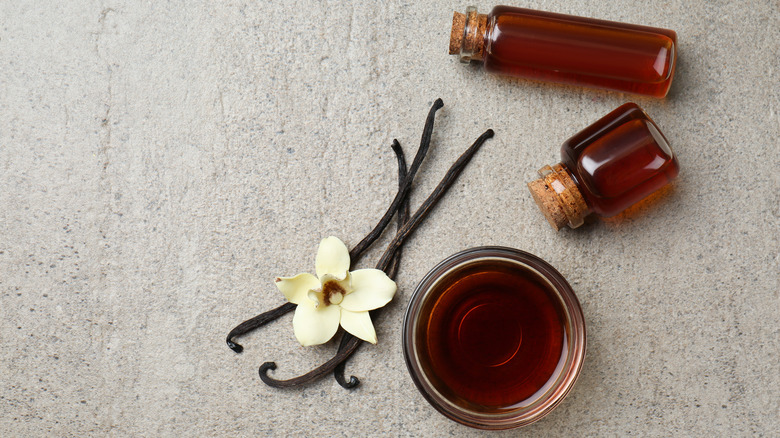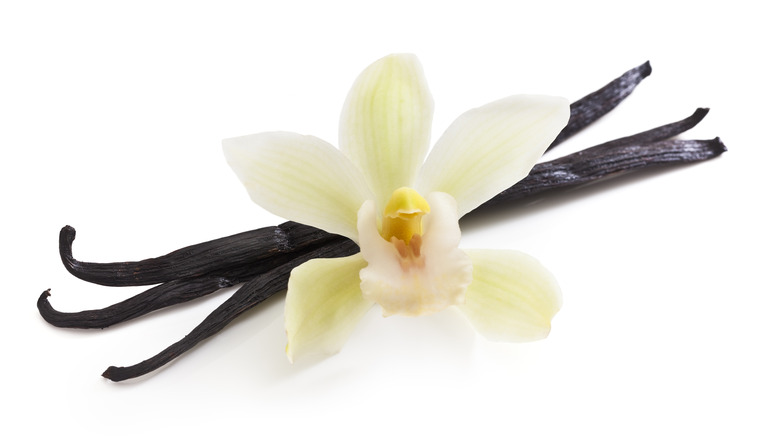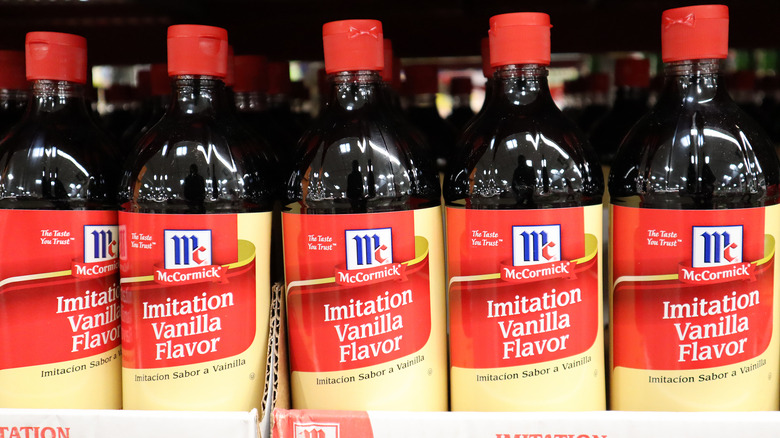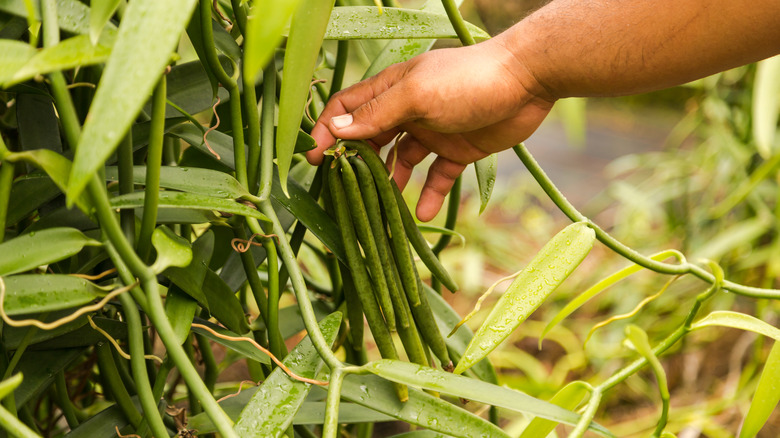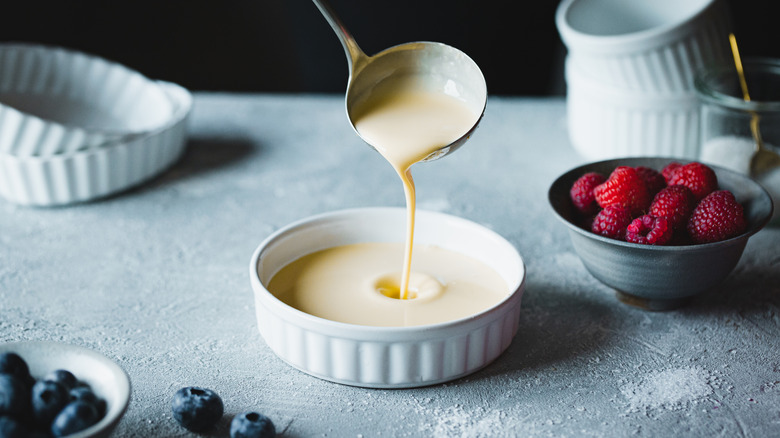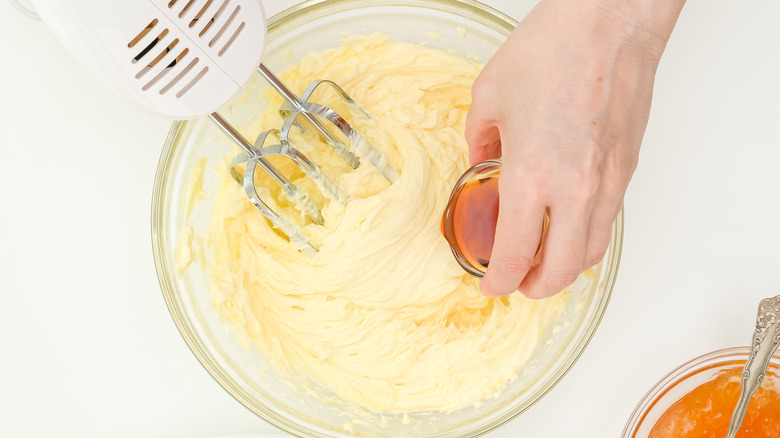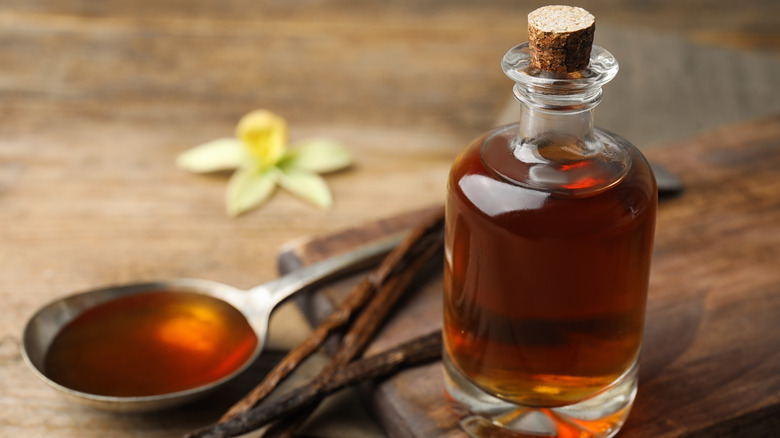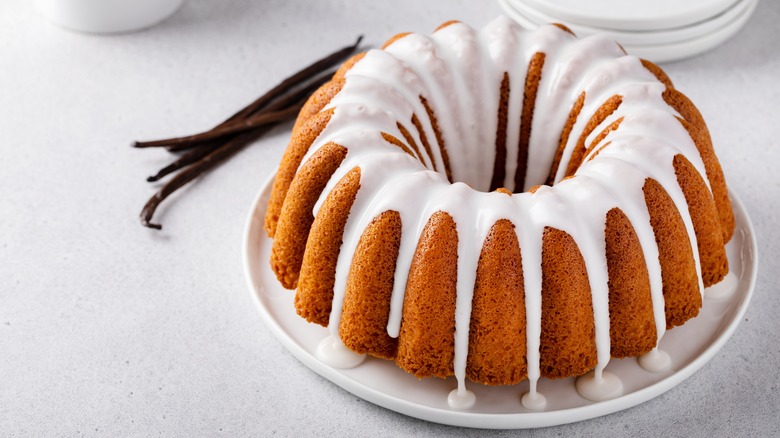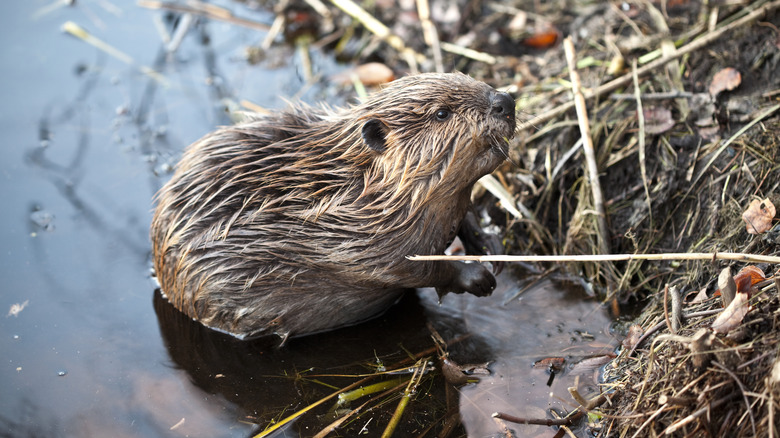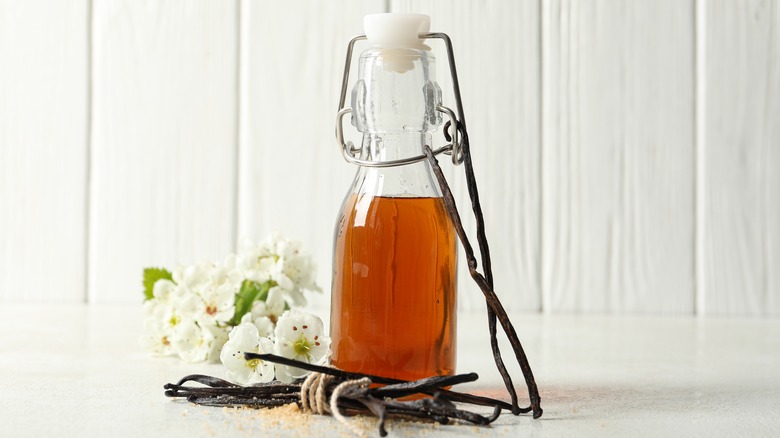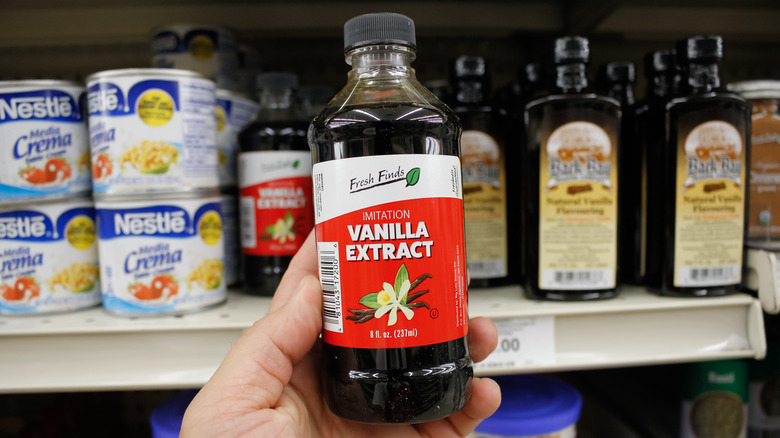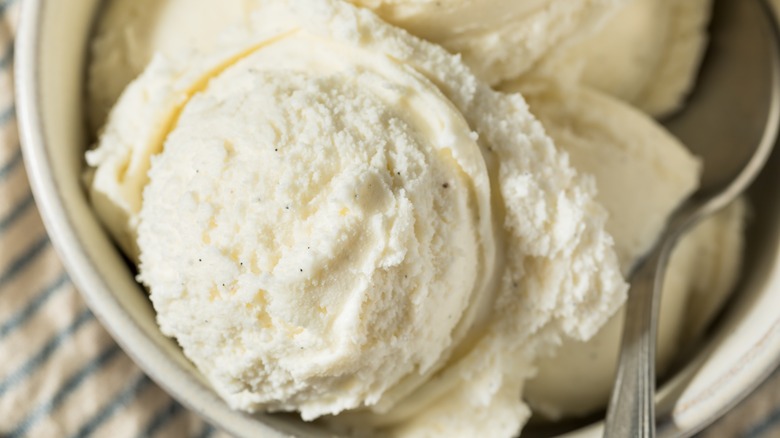Imitation Vanilla Extract Vs Pure: What's The Difference?
Vanilla is an incredibly common flavor in home baking, delivering that distinct warm, sweet, and aromatic taste that makes your sweet treats taste extra comforting and delicious. When choosing which type of vanilla to purchase at the store, you might have noticed that this ingredient comes in a variety of forms, from whole, dried vanilla pods to those little bottles of syrupy amber-colored liquid. Today, we're focusing on two of the most popular forms of vanilla — pure vanilla extract and imitation vanilla (also known as vanilla essence).
Both pure vanilla and imitation vanilla have their place in the kitchen, but each brings different qualities to the table. Pricier pure vanilla is valued for its deep, natural flavor, which comes from real vanilla beans. On the other hand, the more affordable imitation vanilla is synthesized from a combination of other compounds, that, as the name suggests, can closely imitate the flavor and aroma of real vanilla.
But the differences don't end there, and the natural qualities of pure vanilla don't always simply render it superior. In this article, we'll delve into the details of these two forms of vanilla, exploring what makes each one unique and helping you decide which variety is the best fit for your next home bake or dessert.
Pure vanilla extract is made with real vanilla beans
One of the key differences between pure and imitation vanilla extract is the source of their ingredients. The genuine, rich flavor of pure vanilla extract is down to the real vanilla beans with which it's made. These beans (or pods) come from a type of climbing orchid in the Vanilla genus, which are grown in tropical regions such as Madagascar and Mexico. Growing on vines, the orchids produce flowers, which are then hand-pollinated. This leads to the formation of the vanilla pod, which can be harvested around nine months later.
To make pure vanilla extract, the pods are first blanched and fermented, before being dried out in the sun for several weeks. Next, the pods are ground up and soaked in a solution of alcohol and water. This extraction process draws all of the amazing flavor compounds out of the pods, including vanillin, which is responsible for that signature vanilla aroma and taste we know and love.
This means that a true pure vanilla extract should contain just three ingredients — vanilla beans, water, and alcohol. On the other hand, imitation vanilla gets its flavor from synthetic vanillin, which is typically sourced from other ingredients rather than real vanilla beans. Imitation vanilla will often contain a number of other flavorings to try to replicate the taste of true vanilla.
Imitation vanilla comes from wood pulp
While imitation vanilla extract can do a pretty stellar job of replicating the flavor and aroma of real vanilla, it is not derived from real vanilla beans. Like its natural counterpart, imitation vanilla contains vanillin, the primary compound responsible for that distinctive vanilla taste. But this is actually a synthetic version of vanillin, extracted from other sources such as spices, wood pulp, and even petrochemicals. Since these other sources contain molecules with a similar structure to vanillin, scientists are able to transform them into synthesized vanillin, which is in fact identical in chemical makeup to the vanillin found in pure extract.
To extract vanillin from wood pulp, a molecule called lignin must first be isolated from the pulp. The components of lignin are close in chemical structure to vanillin, making it easy to break down through a process called oxidation, and convert into the flavoring agent. To make imitation vanilla, the synthetic vanillin is usually combined with water, preservatives, coloring, and other flavorings to give it as authentic of a look, smell, and taste as possible.
Pure vanilla extract is more expensive than imitation vanilla
A major factor when deciding whether to opt for pure or imitation vanilla is the price tag, with the difference between the two being pretty substantial. Since pure vanilla extract is made from real vanilla beans, it is significantly more expensive than its synthetic counterpart, and several factors contribute to the difference in cost.
First, the cultivation of vanilla beans is particularly labor-intensive and time-consuming. Vanilla orchids take up to three years to reach maturity and begin flowering. They must then be hand-pollinated by farmers, which leads to the formation of the prized vanilla pods. But, there's another eight- to nine-month wait before the pods are ready for harvest. And the work doesn't end there. Next, the vanilla pods must undergo a lengthy curing process before they're ready for use in the production of vanilla extract. It's a long, meticulous process from bean to bottle, which of course is essential to ensure a rich and complex flavor profile. This inevitably drives up the cost.
In contrast, imitation vanilla is made from cheaper raw materials like wood pulp or petrochemicals, allowing for mass production at a fraction of the cost. Here, the manufacturing process is free from the agricultural costs and challenges that come with growing vanilla orchids, making the process quicker and more streamlined, therefore resulting in a far more affordable product.
Pure vanilla has a more complex flavor
So if the primary flavor compound in both pure and imitation vanilla extract is chemically identical vanillin, why do they taste different? Well, despite vanillin being the most prominent flavor, pure vanilla extract actually contains hundreds of different flavor compounds, which are naturally present in real vanilla beans. This gives pure vanilla a much more complex flavor profile, with layers of different notes and aromas contributing to its well-rounded, authentic taste.
With imitation vanilla extract, the focus lies far more heavily on the vanillin flavor, with the absence of other natural compounds. This means it can lack that rich array of sweet, spicy, fruity, or smoky flavor notes, resulting in a one-dimensional taste that can sometimes come across as artificial or overly sweet.
Due to its deeper, richer flavor profile, many chefs prefer to use pure vanilla in their desserts and bakes, claiming there is a noticeable difference in taste between pure and imitation vanilla varieties. The complexity of pure vanilla is particularly evident when it is used in recipes where it stands out as the primary flavor. For example, in custards, ice creams, and simple cakes.
You might need to up the quantity if using imitation vanilla in a recipe
In many cases, you should have no problem substituting pure vanilla extract for imitation vanilla in your recipes. However, this can depend on what type of recipe you're making, as well as the brand of vanilla you opt for.
For certain recipes, if subbing in imitation vanilla, you might need to adjust the quantity to achieve a similar flavor. This is because imitation vanilla can sometimes lack the strength and complexity in flavor of pure vanilla extract. For example, if a recipe calls for one teaspoon of pure vanilla extract, you might find that you need to use up to two teaspoons of imitation vanilla to achieve a similar vanilla intensity.
According to Wilton, you can substitute pure for imitation vanilla in a one to one ratio when making most baked goods such as cakes, brownies, and cookies. However, in unbaked desserts and sweet treats where the flavor will be more noticeable, like vanilla frosting, homemade custard, and ice cream, they recommended doubling the amount of imitation vanilla if using it in place of pure vanilla.
Pure vanilla extract must contain alcohol
Another defining characteristic of pure vanilla extract is its alcohol content. According to FDA standards, for a vanilla extract to be labelled as "pure," it must contain a minimum of 35% alcohol by volume. This quantity ensures sufficient extraction and preservation of the complex flavors found in vanilla beans.
The alcohol found in pure vanilla extract serves an essential purpose. Firstly, it acts as a solvent, helping to extract the wide array of flavor compounds from the vanilla beans, breaking them down and allowing them to infuse into the alcohol and water mixture.
Secondly, alcohol acts as a preservative. The high alcohol content gives pure vanilla extract a very long shelf life. It can in fact remain stable and retain its flavor for up to five years if stored in a cool, dark, and dry place like a kitchen cupboard or pantry. This is a big plus for chefs and home bakers, who can benefit from the cost-effectiveness of buying vanilla extract in bulk, without worrying about to needing to use the product up quickly. Imitation vanilla does not typically contain alcohol, and therefore tends to have a shorter shelf life of between six to 12 months.
Imitation vanilla can be just as flavorful in baked goods
Yes, pure vanilla is prized for those umatched complex flavors, but there are some cases where imitation vanilla might actually be a better choice for your homemade creations. Surprisingly, when it comes to certain baked goods, the flavor of imitation vanilla can shine through just as well as pure vanilla.
In recipes that involve high-heat baking processes, the subtle complexities of pure vanilla can sometimes get lost, as in chocolate chip cookies, brownies, or cakes. This is because many of the array of flavor compounds found in pure vanilla are highly volatile, and simply evaporate away in the presence of heat. Therefore, the result after baking may end up being pretty similar to what you'd achieve with the more vanillin-focused imitation varieties.
When Epicurious conducted a vanilla taste test, baking two batches of sugar cookies that contained either imitation or pure vanilla, the majority of tasters could not distinguish any differences between the two. In fact, two people actually preferred the taste of the cookies that used imitation vanilla. However, when it comes to desserts that aren't subjected to high heat, most would argue that pure vanilla extract is best. The lack of heat means all of those unique, natural flavors present in pure vanilla will be preserved. In sweet treats like puddings, creams, and custards, it's worth splashing out on the real stuff, as that distinct taste of pure vanilla can really shine through.
Imitation vanilla does not come from beaver butts
You might have come across the slightly concerning claim that imitation vanilla extract comes from the rear end of beavers, specifically from a substance called castoreum. Have no fear. Whilst this idea might make for an interesting trivia fact, it is not accurate.
Castoreum is indeed a secretion from the castor glands of beavers, located near the base of their tails. Historically, it has been used in perfumes and occasionally as a food additive due to its vanilla-like aroma. However, the use of castoreum in food, especially in vanilla flavoring, is extremely rare today. The process of harvesting castoreum is both labor-intensive and costly, making it pretty impractical for use in the food industry.
Modern imitation vanilla extract is made primarily from synthetic vanillin which, as we know, is a lab-made substance usually derived from sources like wood pulp or petrochemicals. These sources are far more practical, economical, and therefore widespread ways to produce imitation vanilla, so you can rest assured it's highly unlikely that little bottle in your kitchen cupboard has any connection to beaver butts!
You can make your own pure vanilla extract
Since pure vanilla extract typically contains just a couple of ingredients, it's easy enough to make your own batch at home. You'll only need to spare a few minutes of time for the prep, and with a little patience you'll be rewarded with a batch of fresh, flavorful, pure vanilla extract.
To make your own pure vanilla extract, you'll need some vanilla beans and a high-proof alcohol (proof refers to the ethanol content of the liquor). Sally McKenney of Sally's Baking Addiction recommends using an 80 proof alcohol to make vanilla extract, such as vodka, though you can also use bourbon, brandy, or rum.
First, use a sharp knife to make a slit lengthways down the center of the vanilla beans. This will reveal those flavorful seeds inside the pod. Then, simply pop the cut beans in a bottle or jar and top it up with the alcohol. A ratio of two vanilla beans per 375 milliliters of alcohol is recommended. Once the bottles are filled, seal them securely and give everything a good shake. You'll then want to leave the vanilla to infuse for at least one month, or up to a year for optimum flavor intensity.
The majority of vanilla extracts available in grocery stores are imitation
Due to its cheaper and more simplified production process, imitation vanilla is a readily available product found in the baking aisle at most grocery stores. Though pure vanilla is the variety of choice for many, imitation vanilla is far more prevalent, with 99% of the world's vanilla extract coming in the latter form.
One major reason for imitation vanilla's popularity is its significantly lower cost. This makes it a more accessible product, perfect for budget-conscious consumers who want to enjoy the flavor of vanilla without the high price tag. For many home bakers and cooks, the difference in flavor between imitation and pure vanilla simply isn't significant enough to justify the added expense, especially in recipes where vanilla is not the star ingredient.
More demand equals more widespread stocking of imitation vanilla, and in some cases, consumers may not even realize they are purchasing imitation vanilla. If you're after the highest quality, natural variety, the key is to look for the word "pure," which means the extract contains real vanilla beans and at least 35% alcohol. Despite being made with real beans and meeting the alcohol requirements, some pure vanilla extracts will still contain added sugars and syrups. So check the labels and opt for those that contain just the three basic ingredients — alcohol, water, and vanilla beans — if you're after the purest form.
There's huge variation in flavor between different brands of pure vanilla extract
We've established that pure vanilla extract boasts a richer and more complex flavor than imitation vanilla, but how does this differ between brands? It's true that the unique flavor profile of each brand of pure vanilla can vary significantly, influenced by factors such as the origins of the beans and the extraction process.
Not all vanilla beans are made equal, and their source will play a crucial role in determining the flavor of the resulting extract. For example, Mexican vanilla can be described as having a slight spiciness and dark, fruity flavor, whilst Tanzanian vanilla is sweeter and creamier due to its higher vanillin content. A rare variety of vanilla sourced from Hawaii is known for its nutty and floral flavor notes, which makes its taste especially distinct.
Furthermore, using the right extraction process is key when it comes to preserving the nuanced flavors that each variety of vanilla bean provides. In cold-extraction, the beans are simply soaked in the alcohol and water solution for an extended period so the vanilla flavors can infuse the liquid. However, some manufacturers will add heat into the mix to speed up the process. This can lead to the destruction of many of the heat-sensitive flavor compounds found in the vanilla beans.
Neither will give you those classic black flecks in your recipe (you'll need vanilla pods or paste)
Ever noticed those signature black flecks in your vanilla ice cream or custard? They're certainly an indicator that a pure form of vanilla has been used in the recipe, but sadly, neither imitation not pure vanilla extract will result in this gourmet look.
These tiny black flecks actually come from the seeds inside the vanilla bean pod, which are not present in vanilla extract due to being strained out in the production process. Therefore, if you're after some added visual appeal, you'll need to use vanilla bean paste, or scrape the seeds from a whole vanilla pod to use in your recipe. Using these forms of vanilla can be especially effective in light-colored desserts like ice cream, panna cotta, or whipped cream, where those little dots are sure to stand out.
Vanilla bean paste is thicker in texture than vanilla extract, since it also contains the whole seeds. It can typically be used to substitute vanilla extract in a one to one ratio. If using a whole pod, just slice it lengthways down the middle and scrape out the seeds. According to Nielsen-Massey, the contents of one pod are equivalent to a tablespoon of vanilla extract or paste.
